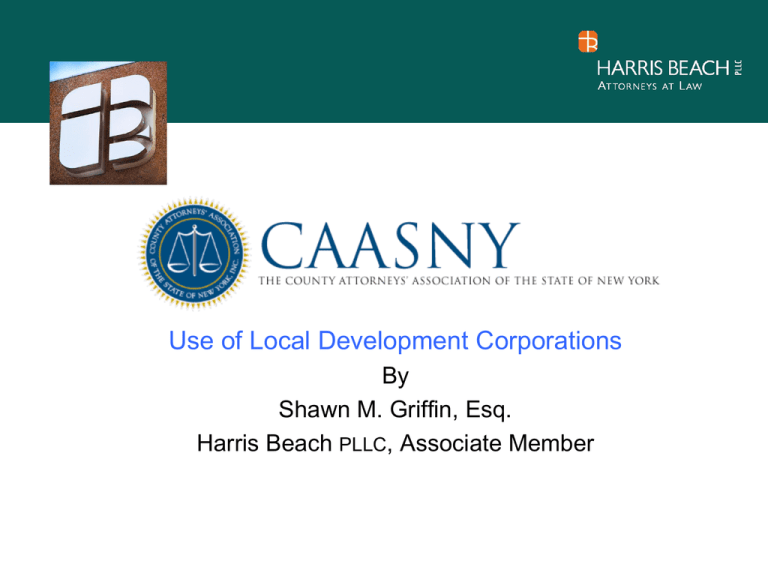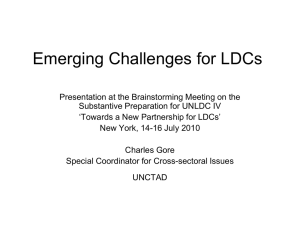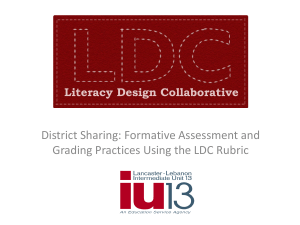
Use of Local Development Corporations
By
Shawn M. Griffin, Esq.
Harris Beach PLLC, Associate Member
Formation of Local
Development Corporations
Local Development Corporations ("LDC") are formed by anyone over the age of 18
and empowered to conduct certain projects pursuant to the New York Not-For-Profit
Corporation Law ("N-PCL") § 1411. (See N-PCL § 1411 attached hereto).
The LDC statute specifically authorizes a County to form a LDC and transfer real
property to the LDC.
The County Legislature must approve the formation of the LDC if you desire to borrow
on a tax-exempt basis, otherwise, mere executive approval for formation may suffice.
(See N-PCL § 1411)
The LDC will have a board of directors comprised of individuals appointed by the
County (could be County Executive or County Legislature). The board of directors
governs and manages the LDC.
The board of directors should have at least 3 directors (See N-PCL § 702).
The members of the board of directors can serve ex officio (for so long as he/she is in
his/her current position) to address PAAA (as defined below) qualifications.
The LDC does not have to have employees as the County can provide services and
employ personnel.
© 2012 Harris Beach PLLC, all rights reserved.
Available at www.HarrisBeach.com
(800) 685-1429
Powers and Purposes of Local
Development Corporations
LDCs can be formed by, and work closely with, municipalities, and provide liability
protection because the LDC is a separate legal entity and can be bankruptcy remote.
The powers of a LDC include, but are not limited to, the ability (i) to acquire by
purchase, lease, gift, bequest, devise or otherwise, real or personal property and (ii) to
borrow money and to issue negotiable bonds, notes and other obligations. (See N-PCL
§ 1411(c) attached hereto)
Unlike other not-for-profit corporations, LDCs are empowered to sell, lease, mortgage
or otherwise dispose of or encumber facilities or any real or personal property or any
interest therein without leave of a court. (See N-PCL § 1411(c) attached hereto)
Specifically, LDCs have the ability to directly acquire real property from municipalities
without the need for public bidding or full market value consideration. (See N-PCL §
1411(d) attached hereto)
Nursing homes serve as an example of municipally owned real property and facilities
that can be transferred to a LDC.
© 2012 Harris Beach PLLC, all rights reserved.
Available at www.HarrisBeach.com
(800) 685-1429
General Rules on Sale to LDC
As discussed, pursuant to N-PCL § 1411(d), a LDC can purchase or lease real
property owned by a municipality.
The legislative body of the municipality must adopt a resolution authorizing the transfer
of the real property to the LDC. (See N-PCL § 1411(d)(1))
The terms of the transfer, including but not limited to price and rental, may be agreed
upon by the municipality and the LDC, and may be undertaken by the municipality
without need for appraisal or public bidding (See N-PCL § 1411(d)(2)).
In accordance with N-PCL §§ 1411(3) and (4), the municipality must schedule and
conduct a public hearing on 10 days' notice.
If the LDC is to issue tax exemption bonds, after the public hearing, the legislative
body of the municipality should approve the formation of the LDC or tax counsel should
look at all other factors to determine if the LDC qualifies as an issuer without County
legislative action. Hot topic – does the legislative body need to approve LDC as
issuer?
© 2012 Harris Beach PLLC, all rights reserved.
Available at www.HarrisBeach.com
(800) 685-1429
Transfer Real and Personal Property
County Law § 215(4) and (5): board determines real property not required for public
use, and adopts resolution authorizing the transfer of the land.
County Law § 215(6): real property may be sold or leased only to the highest bidder
after public advertisement (unless a local law is passed).
The Property being transferred is likely a combination of Real and Personal Property.
Personal property can be dealt with by County resolution.
Likely relying on County Law Section 215 for personal property and N-PCL § 1411 for
Real Property such that mere County Resolution after 10-day notice of public hearing
is all that is required to transfer to an LDC.
© 2012 Harris Beach PLLC, all rights reserved.
Available at www.HarrisBeach.com
(800) 685-1429
Selling the County Nursing Home
Many New York counties entered the nursing home business when the private sector
was not meeting the need for nursing home care. In recent years the private sector has
established facilities which often causes county run facilities to lose high paying patients
and operate at a deficit.
To address these deficits, we have recommended that counties form LDCs and transfer
the facilities to the LDCs, as discussed below.
Charter issues?
Taylor Law Issues – will Buyer be a successor with bargaining obligations and contract?
Legislative bodies change and this allows one vote.
GASB 48 revenues since tobacco deals.
12-18 month CON process means advance planning required and Buyers can change
or fail.
Zoning and subdivision issues to avoid Town veto.
© 2012 Harris Beach PLLC, all rights reserved.
Available at www.HarrisBeach.com
(800) 685-1429
County Nursing Home Example
Following the formation of the LDC (the "County LDC") and the public hearing, the
County transfers the nursing home facility (the "Facility") with the County retaining a
renewable right to operate the Facility.
By retaining an interest sufficient to continue operations, the County can make the
required finding that "…the real property owned by the county, …… is not required for
use by such county, …" (See N-PCL § 1411(d)(1).
This interest retained by the County would be reflected in a "Leaseback Agreement"
whereby the County pays the cost of the County LDC and continues to operate the
Facility without any change in employment.
The board of directors of the County LDC considers the options for the Facility and
terminates the continuing County interests when a new licensed operator can provide
services at the Facility.
Additionally, the LDC can issue bonds and pay the County for the property interest
obtained so as to provide funds to the County to pay for the continuing deficits while
the County operates the Facility. Amounts paid by the LDC to the County must be
used first for repayment or defeasance of County debts associated with the Facility.
You should review GASB 48 when budgeting for such payments.
© 2012 Harris Beach PLLC, all rights reserved.
Available at www.HarrisBeach.com
(800) 685-1429
OSC and the Authority Budget Office
LOVE LDCs
The Authority Budget Office – beyond statutory compliance with biting reports.
PAAA and PARA are applicable to LDCs affiliated with, sponsored by, or created by a
county, city, town or village. (See Public Authorities Law § 2 attached hereto)
Pursuant to PAL § 2800(2) (attached hereto), within ninety (90) days of the end of its
fiscal year, the LDC must submit to the CEO, the CFO, the chairperson of the local
government, and the Authorities Budget Office an annual report.
Use County personnel or your outside consultants to comply with PAAA reporting.
© 2012 Harris Beach PLLC, all rights reserved.
Available at www.HarrisBeach.com
(800) 685-1429
OSC wants audit rights
Can an LDC really be formed for “and lessening the burdens of government and acting in the public
interest, ..”
“Comptroller DiNapoli is advancing a reform agenda that would give OSC direct audit authority over
LDCs and other private organizations controlled by one or more local governments, and would limit
the ability of local governments to circumvent the law by utilizing LDCs and other private
organizations to finance the operations or capital assets of the local government.” Page 1 of OSC
Division of Local Government and School Accountability April 2011 Report on “Municipal Use of Local Development
Corporations and other Private Entities: Background, Issues and Recommendations”
The Office of the New York State Comptroller ("OSC") has called into question the breadth of
authority that can be exercised by an IDA, specifically, whether work performed by an IDA
employee for a LDC counts towards State Retirement Benefits under certain circumstances (OSC
2011-1, attached hereto).
OSC 2011-1 focused on situations where LDCs were staffed by employees of an IDA that
participated in the State Retirement System.
According to OSC 2011-1, “an IDA lacks authority to hire employees and assign them to serve as
staff for not-for-profit corporations.”
OSC 2011-1 put into jeopardy retirement benefits of IDA employees, if the IDA employee performed
duties beyond "IDA Core Activities" (staffing a LDC), then that time may not qualify for State
Retirement Benefits.
© 2012 Harris Beach PLLC, all rights reserved.
Available at www.HarrisBeach.com
(800) 685-1429
Conclusion – NYS Counties need LDC
powers now more than ever!
Certain County assets, namely in the “Enterprise Fund” area, cannot be operated
without losses by a County.
Counties are subject to legislative pressures so one vote transactions are favored.
Counties have limited authority to sell assets with ability to sell to LDC our greatest
tool for flexibility.
CAASNY should carefully monitor any attempts to limit use of LDC by Counties as we
all struggle within the tax cap and normal budgetary constrains to free NYS Counties
of Enterprise Fund “assets” that are a liability for the County and an asset for a private
sector operator.
© 2012 Harris Beach PLLC, all rights reserved.
Available at www.HarrisBeach.com
(800) 685-1429









